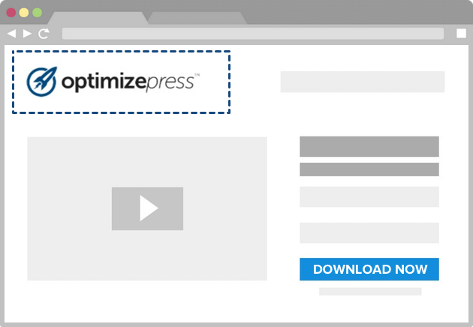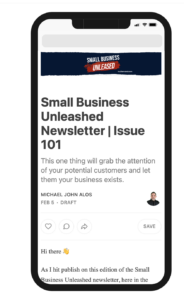The goal of any landing page is to get the visitor to take a specific action to get the visitor to commit to a conversion event. Whether you’re asking for email info or selling a product, your landing page introduces a visitor to an offer. That offer is written with comply copy that describes what is being offered on that landing page and what action the visitor is to take.
Experienced marketers create a new landing page for each campaign, for each offer and each promotion they run. The message on the landing page should be consistent with the ad or social post the visitor saw that got them to the landing page. The message should also be consistent with what is being downloaded from the landing page. On top of that, there are elements that experienced marketers want to continually test to see if they can optimize the conversion of the landing page.
If you’re a small business or have a small marketing team, you may not have the time or the resources to create landing pages for each campaign or spend time in the weeds split testing and optimizing each landing page. At a minimum, there are a few landing page strategies that you should consider each time you build a landing page for your business.
1. Specific page for Specific reason
You don’t need to see all results of all of the many marketing tests that have been run to realize that the more specific your landing page is to the offer you are providing, the more the page will convert. Ensure your landing page provides real value to the visitor.

Explain, in plain English, what your offer is and why it is of value to your visitor. If your ad campaign targeted a specific industry, don’t send that traffic to a generic landing page. Customize the content of your landing page to the specific language that the industry uses.
2. Keep it short and simple or maybe go long
Typically, less is more. People are busy. Your visitor has many distractions in front of him, continuously competing for your visitor’s attention. Once you determine the goal of your landing page, figure out how much copy is necessary to get your point across or spell out the value in your offer. Keep in mind, just because you’re giving away a free ebook, you still need to sell “free”. Whether you’re introducing a free offer or paid product, get to the point as fast as you can in your copy.

As a general rule, I and the team at truDemand have found that longer-form landing pages out-perform short pages for products that are more complicated in nature or higher-priced, therefore more content is needed to build rapport with the visitor. Shorter-form landing pages work for products that are very easy to understand or have a low price point. If you decide that your page warrants longer copy, you want to keep it only long enough to tell your story and present your value.
3. Continuity from ad to landing page
Trust is key to every relationship. At that very moment, a visitor clicks your ad, you are entering a relationship with that visitor. Inconsistent messaging is a sure way to destroy trust. The message in your ad or social post should in alignment with the message on your landing page.
Looking at an ad for Halogen Software, they use the term “Talent Management Made Easy”.


When a prospect clicks through to Halogen’s landing page, they see a consistent message with the phrase “Talent Management simplified”.
If someone clicks on your ad for a free ebook and your landing page is offering a book that costs $10, then there is inconsistency in your messaging. The visitor clicking on your ad expecting a free ebook. However, when they read through your landing page, they are now told that in order to get your ebook they need to pay for it.
Not only will you lose a conversion at this point, the next time this person sees an ad from your company, but they will also wonder what the “catch” is. If they happened to see your offer as a social post, you might start to lose credibility in the eyes of your followers.
4. Personalize your copy
When creating the copy for your landing page, you should be writing with a specific person in mind. This person is typically the person you described in detail when you created the customer personas before you started your campaign(s). If you’re not familiar, a customer persona is a fictional, generalized representation of your ideal customer. Personas help everyone in your business, your teams in marketing, sales, product, and services, internalize who the ideal customer you’re trying to attract, and relate to your ideal customers as real human beings.

Keeping your customer personas in mind when you write your landing page copy, you’ll be able to write benefit-driven copy that is straightforward. You’ll now have your ideal customer’s pain points on top of your mind as you write and be able to address those pains.
Personalizing a landing page by adding a returning visitor’s name to the page is very common.
There are ways to personalize your landing page using information that you might already know about your visitor. There a quite a few tools that allow you to add dynamic text to landing pages and have that dynamic text change depending on who is visiting your page.
5. Keep their eyes on your offer
The goal of your landing page is to get a conversion. Having even a single link might distract from conversion. Your landing page should have your opt-in form and your copy- that’s it! No menus or links.
A few caveats here. If you’re running ads, you might have to have links to your terms of service, privacy policy, or the link. Some ad platforms require your landing page link to these types of pages.

My personal preference is to include a link to your company’s home page. I typically like to do this by having my company’s logo on the page and having the log linked to my home page. I encourage this practice for this reason, even with the most compelling offer, if a visitor has never heard of your company, they might be hesitant to give you their email or take the next step.
The OptimizePress example is a landing page with its logo.
If you give them a link to your home page, they will have the opportunity to learn more about who you are, then a few clicks on the back button and they’re back at your landing page, ready to take that next step.
6. Use more video
I admit it. I’m not a big fan of using video on my landing pages. Personally, I don’t have the time to sit through a video. I’m not always in a place where I can listen to a video, such as when my son is sleeping. But, research has proven that video is a great way to increase engagement and create more conversions on your landing pages.

According to Social Media Today, videos have 135% greater organic reach than photo posts on Facebook. So instead of only telling your visitors about the value of your offer, use video to show them the value they’ll receive once they have your offer in their hands.
Dollar Shave Club does an amazing job of using video on their landing pages.
6. Use social proof
A great way to increase conversions of your landing pages is to reduce the risk to your visitor. Adding elements to your landing pages such as customer testimonials, partner logos, chamber of commerce logos, and case studies, are all great ways to build trust in the eyes of your visitors.
Here are a few examples of what social proof on a landing page looks like from GetResponse:

7. Your headline is the first line and the most important line
The headline and sub-head are the most read part of any landing page. The headline is what grabs your visitor’s attention. The subhead is the bridge from the headline to the body copy is might keep the reader reading. Every visitor to your landing page, at a minimum, will read your headline.

“Every visitor to your landing page, at a minimum, will read your headline.” ~ Michael Alos, truDemand.com
Writing headlines is a craft but here are three basic tips for writing headlines that attract attention:
- Your headline needs to be a continuation of the ad or social post that initially attracted your visitor
- The headline should make the reader want to find out more and get them to read on to the subhead
- A headline needs to stand out and grab the reader’s attention. The subheaders should reinforce, support, or add more value to the headline and get the visitor to read on
There have been many books and courses published on writing headlines for a reason. The three tips below are just a little something to get you started.
8. A Landing Page is separate from your website
A landing page is a totally separate page from your website’s home page. Sure, you can send traffic to your home page or any other page of your website. However, a landing page is a specific page created for your offer and the ad campaign you’re running. Above we talked about consistency, personalization, and being specific- none of which can be accomplished if you are sending traffic to your home page.

There’s nothing preventing you from driving traffic to your home page but you’ll be sacrificing conversions and not achieving maximum return on your ad campaign dollars.
If you look at the example above, you can see that the landing page on the right was developed with the specific intent of the goal of conversion. It has a headline, form, and copy. Looking at the home page on the left, there is no clear headline, no form, and no call to action.
9. Perform basic Search Engine Optimization (SEO) of your landing page
By following the strategies outlined above, you’ll eventually discover that your website has more landing pages than you think. While your landing page might never rank on the first page of Google for a keyword, performing basic SEO on your landing pages is worth the few minutes it will take.

Even if you are driving page traffic to your landing pages, it’s still a good practice to keep Google happy and to do the following:
- Make sure your landing page is mobile-friendly and responsive
- Add meta descriptions and title tags
- Create a text headline using an H1 tag
- Avoid popups, overlays, and the like that take up the entire page or device screen
In closing, creating great landing pages that convert is an art. It requires constant testing, tweaking, and ongoing optimization. At truDemand, we have an entire framework that we walk our clients through in order to optimize the conversion rate of our client’s landing pages and maximize the investment into lead generation programs. The strategies I outlined above will give you a good foundation to apply to any of your current landing pages or landing pages you’ll create in the future.

